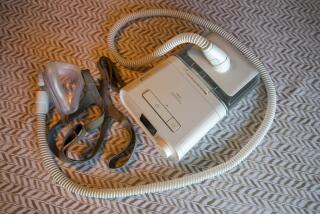Heart Device Warning May Change
- Share via
WASHINGTON — The Food and Drug Administration is considering not using the word “recall” to warn patients and doctors about defective pacemakers and defibrillators at the request of a physician group struggling to deal with a loss of public confidence in the safety of implantable heart devices.
FDA officials said they were conducting focus groups to see whether the currently used “recall” term was causing undue alarm when used to refer to heart devices the agency had decided might be faulty.
“It’s a terrible term,” said Dwight Reynolds, president of the Heart Rhythm Society, an association of doctors who implant the devices. “The anxiety created among patients and physicians by this term is the No. 1 cause for replacement of devices.”
Patients who learn they have a faulty device often assume they need to have it removed immediately, even though the surgical procedure to replace the device typically involves more risk than leaving it in, Reynolds said.
The Heart Rhythm Society released guidelines Thursday, asking the FDA to use “safety advisory” or “safety alert” when referring to device problems.
The FDA has previously said eliminating the “recall” term would require changing federal law, but physicians and manufacturers disagree. They met with lawmakers this week to see whether a non-legislative solution could be negotiated with regulators.
The request faces obstacles, however, because “the term ‘recall’ is used across many different kinds of products” at the FDA, said Bram Zuckerman, head of the agency’s cardiovascular device division.
Industry leaders Medtronic Inc., Boston Scientific Corp. and St. Jude Medical Inc. have already adopted many of the society’s other recommendations, which appeared in draft form in April.
The companies have said they will simplify how they communicate device performance, appoint external panels to review device problems and implement wireless systems that enable doctors to remotely monitor patients.
The FDA has issued safety alerts and recalls affecting more than 337,000 defibrillators since 1990. On average, fewer than 5 in 1,000 pacemakers and 21 in 1,000 defibrillators have had malfunctions resulting in replacement.
The number of defibrillators implanted in the U.S. has shrunk 8% in the last 12 months, according to Prudential Equity Group. The drop comes after a decade when defibrillator use expanded from 21,000 patients in 1995 to 250,000 last year. Industry analysts blame the slump on a series of highly publicized device safety problems that occurred last year.
The most controversial case involved Guidant Corp.’s Prizm defibrillators. Guidant, since acquired by Boston Scientific, fixed the problem in 2002 but did not inform patients and physicians until after the 2005 death of a patient with one of the devices.
Implanted in the upper chest, defibrillators monitor the heart for deadly irregular heartbeats and use electrical shots to jolt it back to normal, whereas pacemakers use lower-voltage electrical pulses to correct dangerously slow heart rhythms.
More to Read
Inside the business of entertainment
The Wide Shot brings you news, analysis and insights on everything from streaming wars to production — and what it all means for the future.
You may occasionally receive promotional content from the Los Angeles Times.










